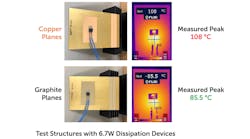Teledyne Labtech has developed the capability to embed layers of synthetic graphite within RF and microwave printed circuit boards (PCBs). Heat management is a significant concern in many aerospace defense and space applications where size, weight, and power (SWaP) are key attributes. Gallium-nitride (GaN) solid-state power amplifiers (SSPAs) are examples of increasingly common devices that benefit from careful heat management. This new technique allows for efficient conduction of heat away from such devices, saving system weight and increasing their lifetime.
Managing waste heat is a significant problem in today’s electronic systems, impacting reliability and requiring added expense and weight to control effectively. In the latest consumer mobile phones, it's common to employ sheets of self-adhesive synthetic graphite on top of critical semiconductor devices to conduct away waste heat from small areas. Aerospace, defense, and space applications require more precision, repeatability, and area of coverage.
To address this, Teledyne Labtech devised a method of embedding thin layers of synthetic graphite inside the structure of the host PCB reliably, saving size and weight, while increasing the lifetime of active devices (MTBF) by permitting operation at cooler steady state.
“Synthetic graphite is 4X lighter than copper, and transfers heat 4X better in the X-Y plane,” said John Priday, CTO of Teledyne Labtech. “Replacing PCB ground plane layers with it in critical applications such as T/R modules can cause devices to run up to 20°C cooler in our testing.”
Labtech has demonstrated that thermal copper layers can be replaced with the new graphite technique while remaining reliable and experiencing minimal impact on the passage of microwave signals on grounding layers.
